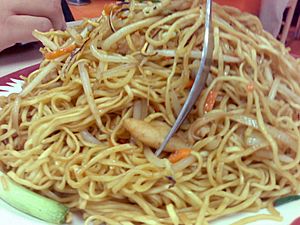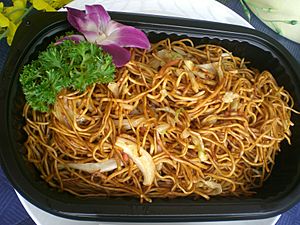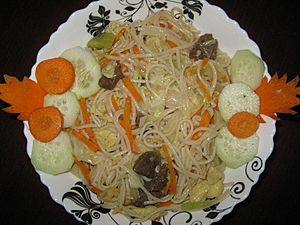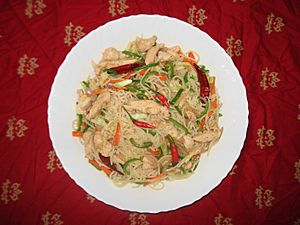Chow mein facts for kids
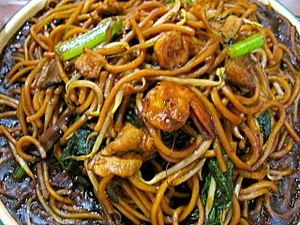
A plate of chow mein
|
|
| Course | Main course |
|---|---|
| Place of origin | China |
| Region or state | Guangdong |
| Serving temperature | Hot |
| Main ingredients | Noodles, soy sauce, vegetables |
| Variations | Chicken, pork, beef, shrimp, tofu |
| Chow mein | |||||||||||||||||||||
|---|---|---|---|---|---|---|---|---|---|---|---|---|---|---|---|---|---|---|---|---|---|
| Traditional Chinese | 炒麵 | ||||||||||||||||||||
| Simplified Chinese | 炒面 | ||||||||||||||||||||
| Literal meaning | "Stir-fried noodles" | ||||||||||||||||||||
|
|||||||||||||||||||||
Chow mein is a super popular Chinese food dish. It means "stir-fried noodles" in Chinese. This tasty meal usually has noodles, vegetables, and sometimes meat or tofu, all cooked quickly in a hot pan.
Chow mein is enjoyed by people all over the world. You can find it on the menu of most Chinese restaurants outside of China. It's especially popular in places like India, Nepal, the UK, and the US.
What Does "Chow Mein" Mean?
The name "chow mein" literally means 'stir-fried noodles'. The word chow means 'stir-fried' or 'sautéed'. The word mein means 'noodles'.
The way we say "chow mein" in English comes from the chāu-mèn sound in the Taishan dialect. This dialect was spoken by many Chinese people who moved to North America from the Toishan area.
Chow Mein Around the World
Chow mein is made in many different ways across the globe. Each country or region often adds its own special touch to the dish.
American Chinese Chow Mein
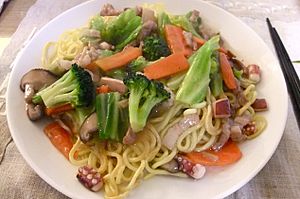
In American Chinese cuisine, chow mein is a stir-fried dish. It usually has noodles, meat (like chicken, pork, beef, shrimp, or tofu), onions, and celery. Many Chinese restaurants in the West serve it. You can also find vegetarian or vegan versions.
There are two main types of chow mein in America:
- Steamed chow mein: This type has a softer texture.
- Crispy chow mein: This is also called Hong Kong-style chow mein. It's crunchier and drier.
Crispy chow mein often uses flat, fried noodles. Soft chow mein uses long, round noodles. Crispy chow mein might have a thick brown sauce on top. Steamed chow mein is usually mixed with soy sauce before it's served.
The word "chow mein" can mean different things depending on where you are in the US. On the East Coast, "chow mein" usually means the crispy kind. The softer noodle dish is often called "lo mein". On the West Coast, "chow mein" usually means the steamed, soft noodle style. The crispy kind is often called "Hong Kong style."
Sometimes, crispy chow mein is even served in a hamburger bun. This is called a chow mein sandwich.
Australian Chinese Chow Mein
In Australia, traditional chow mein uses egg noodles. These noodles are boiled, dried, and then stir-fried. They are pressed down in the wok to make them crispy on the edges.
Australian chow mein can have seafood (like prawns), chicken, beef, or barbecued pork. The sauce is made with garlic, rice wine, light stock, MSG, salt, and corn flour. Common vegetables include bok choy or choy sum and a little carrot. This dish is special because its noodles are both soft and crispy.
Brazilian Japanese Chow Mein
Chow mein came to Brazil through Japanese immigrants. There, it's called yakisoba. Brazilian yakisoba is often more like the North American versions of chow mein than Japanese ones.
You can find yakisoba in many Asian restaurants across Brazil. It usually comes with chicken, beef, shrimp, or pork. It's often served with lots of soy sauce, sesame oil, and vegetables. These vegetables almost always include carrot, cabbage, onion, and a dark green leafy vegetable like Chinese cabbage.
Another popular dish is yakibifum. This is similar to yakisoba but uses rice vermicelli noodles instead of wheat noodles.
Canadian Chinese Chow Mein
Westernized Chinese restaurants in Canada might offer a few types of chow mein. Cantonese style chow mein has deep-fried crunchy egg noodles. It also includes green peppers, pea pods, bok choy, bamboo shoots, water chestnuts, shrimp, Chinese roast pork, chicken, and beef. All of this is served in a thick sauce.
Plain chow mein in Canada is similar to other Western versions but has many more mung bean sprouts. In some areas, bean sprouts might even replace the noodles completely. Hong Kong style chow mein in Canada is like plain chow mein but is always served on a bed of deep-fried crunchy egg noodles.
In Newfoundland, their chow mein is unique because it doesn't have any noodles! Instead, cabbage cut to look like noodles is used. This might be because the island was very isolated in the past.
Caribbean Chinese Chow Mein
Many people in the West Indian islands, like Trinidad and Tobago and Jamaica, enjoy chow mein. These islands have many people of Chinese background. The chow mein here is cooked with green beans, carrots, peas, onions, and sometimes other vegetables. Chicken is the most common meat, but pork and shrimp are also used. The main difference is that local spices are added. The dish is often served with hot Scotch bonnet peppers or pepper sauce.
In Panama, chow mein is made with shredded carrots, cabbage, pork, or chicken, served over noodles. Some recipes even include canned corn.
Indian Chinese Chow Mein
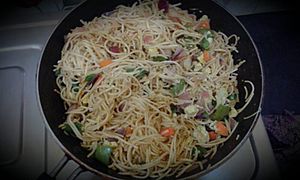
Chow mein is also very common in Indian Chinese, Bangladeshi Chinese, and Pakistani Chinese food. It was first brought to India by Chinese people in Kolkata.
There's an Indian version called vegetable chow mein for those who don't eat meat. It has noodles with cabbage, bamboo shoots, pea pods, green peppers, and carrots. In New Delhi, chow mein can sometimes include paneer (a type of cheese) with the noodles and vegetables. Another version uses scrambled egg for protein. Kolkata has its own special Calcutta Chow Mein, which often includes green chili, chili garlic, or hot garlic.
Indonesian Chinese Chow Mein
Indonesia has two main versions of chow mein. One is Mie goreng, which is a stir-fried noodle dish that can be spicy and has different toppings. The other is a crispy noodle dish topped with a sauce. This is called I fu mie or Mi Siram, which means "drenched noodle".
In Indonesia, i fu mie is usually served with a thick egg sauce. This sauce often has cauliflower, broccoli, mushroom, and chicken. There are also vegetarian and seafood versions with squid, prawn, and fish.
Mexican Chinese Chow Mein
Chow mein is also popular in Mexico, especially in northwestern Mexico. The city of Mexicali in Baja California is known for its unique style of chow mein. It often uses Mexican ingredients instead of traditional Chinese ones. This change happened as Chinese immigrants settled in the area and adapted their cooking.
Nepalese Chow Mein
Tibetans who moved to Nepal brought chow mein with them. It's a popular fast food in Nepal. The Newari people of the Kathmandu Valley often use water buffalo meat and chicken in their cooking. So, chow mein in Nepal is often made with onion, vegetables, and buff (water buffalo meat).
Peruvian Chinese Chow Mein
Chinese food, called Chifa, is very popular in Peru and is now a big part of Peruvian culture. Chow mein is known to Peruvians as Tallarín saltado. This dish can include peppers, onions, green onions, and tomatoes.
See also
 In Spanish: Chow mein para niños
In Spanish: Chow mein para niños


